Visitors at NIMBioS in 2010
Short-term visitors to NIMBioS are supported for periods up to one week to assist their efforts in carrying out research that conforms to the mission of NIMBioS to foster research at the interface between mathematics and biology.
Visitor/Sabbatical Archive
 Robert Holt (Dept. of Biology, Univ. of Florida)
Robert Holt (Dept. of Biology, Univ. of Florida)
Project Title: Linking mathematical models of ecological processes across organizational and temporal scales
Robert Holt is collaborating with NIMBioS Sabbatical Fellow
Vlastimil Krivan
to investigate how labile behaviors alter ecological responses to resource pulses and shifting landscapes.
Visit Dates: Nov. 28-29, 2010
Products
Publication:Dunn AM, Torchin ME, Hatcher MJ, Kotanen PM, Blumenthal DM, Byers JE, Coon CAC, Frankel VM, Holt RD, Hufbauer RA, Kanarek AR, Schierenbeck KA, Wolfe LM, Perkins SE. 2012. Indirect effects of parasites in invasions. Functional Ecology, 26(6): 1262-1274. [Online]
 Peter Turchin (Dept. of Ecology and Evolutionary Biology, Dept. of Mathematics, Univ. of Connecticut)
Peter Turchin (Dept. of Ecology and Evolutionary Biology, Dept. of Mathematics, Univ. of Connecticut)
Project Title: Evolution of social complexity: models of multilevel-selection and intergroup conflict
Peter Turchin is collaborating with Sergey Gavrilets (NIMBioS/UTK) and David Anderson (Dept. of Anthropology, UTK) to use agent-based models in investigating the development of complex hierarchies in response to selection imposed by intergroup conflict.
Visit Dates: Nov. 15-19, 2010
Products
Publication: Turchin P, Whitehouse H, Francois P, Slingerland E, Collard M. 2012. A historical database of sociocultural evolution. Cliodynamics: The Journal of Theoretical and Mathematical History, 3(2). [Online]
Publication: Gavrilets S, Anderson D, Turchin P. 2010. Cycling in the complexity of early societies. Cliodynamics: The Journal of Theoretical and Mathematical History, 1(1). [Online]
Publication: Turchin P. 2010. Warfare and the evolution of social complexity: A multilevel-selection approach. Structure and Dynamics, 4(3). [Online]
Meetings/Workshops: Turchin P, Storrs CT. November 2012. Historical database of sociocultural evolution: Design and coding.
Meetings/Workshops: Turchin P, Fortunato L, Gavrilets S. 2012 February 6-8. Modeling Social Complexity, NIMBioS-NESCent Investigative Workshop, NIMBioS, Knoxville, TN. [Online]
Software, Data, and/or Website: Turchin P, Storrs CT. 2012. Software: Historical Database of Sociocultural Evolution (SESHAT).
 Philip Ryan (Div. of Mathematics and Computer Science,Truman State Univ.)
Philip Ryan (Div. of Mathematics and Computer Science,Truman State Univ.)
Project Title: Training in agent-based modeling
Philip Ryan is visiting NIMBioS for training in agent-based modeling. In his research, he applies agent-based models (ABMs) to mathematical ecology and physiology problems. His research goal is to develop an ABM which analyzes diabetes self-management strategies, especially with type II diabetes, based on the oral glucose tolerance test.
Visit Dates: Nov. 1-12, 2010
Products
Education: Module: Ryan P. 2011. Optimal litter size. Truman State University.
Education: Module: Ryan P. 2011. Computer Lab: Curve fitting and biological modeling. Truman State University's Introduction to Mathematical Biology course.
 Dave McCandlish (Dept. of Biology, Duke Univ.)
Dave McCandlish (Dept. of Biology, Duke Univ.)
Project Title: Evolutionary flexibility of HIV surface proteins
Dave McCandlish is collaborating with Sergey Gavrilets (NIMBioS/UTK) to reconstruct virus exploration of neutral networks corresponding to protein function using publicly available sequence data.
Visit Dates: Oct. 25-30, 2010
Products
Dissertation: McCandlish DM. 2012. Dissertation: Evolution on arbitrary fitness landscapes when mutation is weak. Duke University.
 Jeanne Narum (Project Kaleidoscope)
Jeanne Narum (Project Kaleidoscope)
Project Title: Gathering stories about transformative collaborations that transform undergraduate STEM
Jeanne Narum visited NIMBioS to gather stories about what works in transforming the undergraduate STEM learning environment and to translate them into a series of essays that suggest major areas to be addressed over the next decade.
Visit Dates: Oct. 25-26, 2010
 Ryan Chisholm (Smithsonian Tropical Research Institute)
Ryan Chisholm (Smithsonian Tropical Research Institute)
Project Title: Integrating niche structure into neutral models of community ecology
Visit Dates: Oct. 22-31, 2010
Products
Presentation: Bewick SA, Chisholm RA, Akcay E, Godsoe W. October 2011. Tropical biodiversity: New models for an old problem. Society for Advancement of Chicanos and Native Americans in Science, Modern Mathematics Workshop, San Jose, CA.
Presentation: Bewick SA, Chisholm RA, Akcay E, Godsoe W. August 2011. 'Neutral' models with overlapping niches. The 2011 Annual Meeting of the Ecological Society of America, Austin, TX.
 Mohammad Yahdi
(Dept. of Mathematics & Computer Science, Ursinus College)
Mohammad Yahdi
(Dept. of Mathematics & Computer Science, Ursinus College)
Project Title: Mathematical modeling, analysis, and optimal control of Vancomycin-Resistant Enterococci (VRE)
Mohammad Yahdi is collaborating with Suzanne Lenhart (NIMBioS/UTK) to analyze the dynamic underlying the emergence in hospitals of VRE and to determine strategies for optimal control of its spread without the risk involved in clinical testing.
Visit Dates: October 3 - October 9, 2010
Products
Presentation: Yahdi M. April 2012. Mathematical modeling, transmission dynamics and control of antibiotic-resistant infections. Invited Speaker, Mathematics and Statistics Colloquium, Villanova University.
Presentation: Yahdi M, Dunlea M. April 2012. Modeling and analysis of a multiscale interaction. SIAM/MAA Third Mid-Atlantic Regional Applied Mathematics Conference, Shippensburg University.
Presentation: Yahdi M, Dunlea M. January 2012. Optimal control for a VRE model. AMS Session on Mathematical Biology and Related Fields, American Mathematical Society (AMS), Boston, MA.
Presentation: Yahdi M, Dougherty E, Dunlea M, Watton C. January 2012. Poster: Optimal control theory for a VRE model. Annual Joint Mathematics Meetings of the MAA and AMS, Boston, MA.
Presentation: Yahdi M. 9-11 December 2011. Parameter analysis and optimal control of a VRE model. International conference on Antibiotic-Resistant Infections: Mathematical Modeling, Transmission Dynamics and Control, University of Miami, FL.
Presentation: Yahdi M, Dunlea M. September 2011. Optimal control theory for a VRE model. Annual Summer Research Symposium, Haverford College, PA.
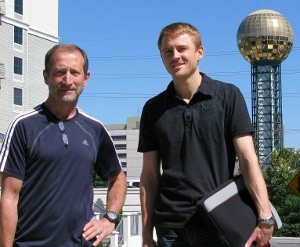
|
| (From left) Bill Rice, Urban Friberg |
Urban Friberg (Dept. of Animal Ecology, Uppsala Univ.) and Bill Rice (Dept. of Ecology, Evolution and Marine Biology, UC Santa Barbara)
Project Title: Homosexuality driven by genetic conflicts between sex chromosomes
Friberg and Rice are collaborating with Sergey Gavrilets (NIMBioS/UTK) on a project to develop a mathematical model that describes the evolutionary dynamics of a genomic conflict that potentially can drive the evolution of homosexuality.
Visit Dates: September 29 - October 3, 2010
Products
Publication: Rice WR, Friberg U, Gavrilets S. 2013. Homosexuality via canalized sexual development: A testing protocol for a new epigenetic model. Bioessays, 35(9): 764-770. [Online]
Publication: Rice WR, Gavrilets S, Friberg U. 2010. The evolution of sex-specific grandparental harm. Proceedings of the Royal Society B, 277(1694): 2727-2753. [Online]
Publication: Rice WR, Gavrilets S, Friberg U. 2009. Sexually antagonistic chromosomal cuckoos. Biology Letters, 5(5): 686-688. [Online]
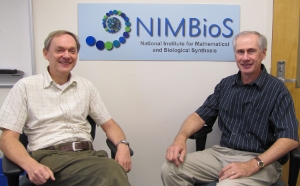
|
| (From left) Vlastimil Krivan, Ross Cressman |
Ross Cressman (Dept. of Mathematics, Wilfrid Laurier Univ.)
Project Title: Habitat selection and multi-species population games
Ross Cressman's project is part of ongoing collaborative research on evolutionary game theory with NIMBioS Sabbatical Fellow Vlastimil Krivan. This research examines how game-theoretic results can extend to cases when time scales can be separated. The primary goal of the project is to generalize heuristic single-species solution concepts such as the Ideal Free Distribution to multi-species models with a long-term goal to develop a more general conceptual approach for multi-species games.
Visit Dates: September 27 - October 2, 2010
 Yoram Louzoun (Bar Ilan Univ., Israel)
Yoram Louzoun (Bar Ilan Univ., Israel)
Project Title: Optimal viral immune surveillance evasion strategies
Yoram Louzoun is collaborating with Vitaly Ganusov (Dept. of Microbiology, Univ. of Tennessee) to develop an optimization framework to compute the number of expected epitopes in different viral proteins and to conduct a bioinformatic analysis of the epitope density in different proteins that correlates with the optimization analysis.
Visit Dates: July 22 - August 17, 2010
Products
Publication: Louzoun Y, Ganusov VV. 2012. Evolution of viral life-cycle in response to cytotoxic T lymphocyte-mediated immunity. Journal of Theoretical Biology, 310: 3-13. [Online]

|
| (From left) Hiroyuki Yokomizo, Richard Hall, Gregory Schrott, John Lambrinos |
Richard Hall (Univ. of Georgia)
John Lambrinos (Oregon State Univ.)
Gregory Schrott (Archbold Biological Station)
Hiroyuki Yokomizo (National Institute for Environmental Studies, Japan)
Project Title: Modeling the effects of habitat fragmentation and biotic resistance on biological invasions
This collaborative group is synthesizing ecological theory, computational modeling and empirical data to understand how habitat fragmentation interacts with local biotic resistance to drive invasion patterns. The simulation model uses a dataset from pampas grass (Cortaderia jubata) as an invasive in California. The results of this study, and the code generated for the model, will have broad applicability for the understanding and management of invasions into human-altered landscapes.
Visit Dates: July 12-23, 2010
Products
Presentation: Lambrinos J. February 2012. Invasion risk in an edgy world. Ecology and Evolution Seminar Series, Oregan State University.
Presentation: Yokomizo H. September 2011. How do landscape heterogeneity and local community resistance interact to affect Cortaderia establishment and spread? Annual Meeting of the Japanese Society of Mathematical Biology.
Presentation: Yokomizo H. March 2011. Modeling the effects of habitat fragmentation and biotic resistance on biological invasions. Annual Meeting of the Ecological Society of Japan.
Grant: Lambrinos J. 2012. Grant to visit Yokomizo in Japan. International Programs Faculty Grant. Oregon State University. $2,000. Accepted.
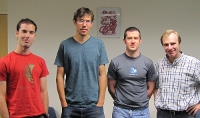
|
| (From left) Michael Bode, Carl Toews, Gareth Lennox, Paul Armsworth |
Paul Armsworth
(Univ. of Tennessee)
Michael Bode
(Univ. of Melbourne)
Gareth Lennox
(Univ. of Sheffield)
Carl Toews
(Duquesne Univ.)
Project Title: Optimal design of spatial and spatio-temporal management strategies for terrestrial biodiversity conservation and fisheries management
This collaborative group of early career mathematical biologists focuses on terrestrial biodiversity conservation and fisheries management. The group is developing and applying constrained optimization techniques to inform the design of management strategies.
Visit Dates: July 4-27, 2010
Products
Publication: Lennox GD, Armsworth PR. 2013. The ability of landowners and their cooperatives to leverage payments greater than opportunity costs from conservation contracts. Conservation Biology, 27(3): 625-634. [Online]
Publication: Lennox GD, Armsworth PR. 2011. The suitability of short or long conservation contracts under ecological and socio-economic uncertainty. Ecological Modelling 222:2856-2866. [Online]

|
| (From left) Redwan Al Faori, M. Letitia Holden Hubbard, Luis Cabrales Arriaga |
Redwan Al Faori (Univ. of Arkansas)
Luis Cabrales Arriaga (Texas Tech Univ.)
M. Letitia Holden Hubbard (Duke Univ.)
Al Faori, Arriaga and Hubbard attended the 2010 Summer School in Biophysics
at the Univ. of Tennessee/Oak Ridge National Laboratory, of which NIMBioS was a co-sponsor.
Visit Dates: July 7-10, 2010
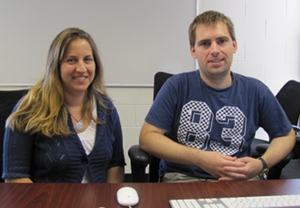 Sadie Ryan
(National Center for Ecological Analysis and Synthesis) and
Sadie Ryan
(National Center for Ecological Analysis and Synthesis) and
Michael Tildesley
(Centre for Infection, Immunity and Evolution, Univ. of Edinburgh)
Project Title: Using GIS to inform spatial epidemic models of disease transmission among US farms
Sadie Ryan and Michael Tildesley are collaborating on research to investigate the geographical resolution required to accurately predict future epidemics of foot-and-mouth disease in the USA, and to create model frameworks that can be adapted to other livestock diseases such as Bovine tuberculosis and Brucellosis.
Visit Dates: June 28 - July 2, 2010
 William J. Platt (Louisiana State Univ.)
William J. Platt (Louisiana State Univ.)
Project Title: Models for savanna dynamics based on differential flammability of trees
Bill Platt is collaborating with Brian Beckage (NIMBioS Sabbatical Visitor) and Louis Gross (NIMBioS) to develop a stochastic model for vegetation-fire feedbacks in savannas as well as a general conceptual model for fire that incorporates short- and long-term feedbacks involving vegetation at local, regional, and global scales. These models will be developed to provide new insights into the role of fire in maintaining grasslands and savannas.
Visit Dates: June 21-25, 2010
Products
Publication: Beckage B, Gross L, Platt W, Godsoe W, Simberloff D. 2012. Individual variation and weak neutrality as determinants of forest diversity. Frontiers of Biogeography, 3(4): 145-155. [Online]
Publication: Beckage B, Gross LJ, Platt WJ. 2011. Grass feedbacks on fire stabilize savannas. Ecological Modelling, 222(14): 2227-2233. [Online]
Presentation: Platt WJ. 2011. Engineering of fire by savanna trees: Effects on overstory and groundcover dynamics. Ecological Society of America Symposium on Model for the Dynamics of Savanna Ecosystems, Austin, TX.
Proposal: Platt WJ. 2011-2013. REU Supplement to "Collaborative Research: Linking models to data to investigate patterns and process in savannas." National Science Foundation. $15000. Accepted.
Publication: Beckage B, Godsoe W, Gross L, Platt W, Simberloff D. July 2010. Individual variation slows competitive exclusion. Science, e-letter published online 14 July 2010. [Online].
Past Collaboration Publication: Beckage B, Platt WJ, Gross LJ. 2009. Vegetation, fire, and feedbacks: A disturbance-mediated model of savannas. The American Naturalist, 174(6): 805-818. [Online]
 Sanjukta Hota (Fisk Univ.)
Sanjukta Hota (Fisk Univ.)
Project Title: HIV research discussion and partnership visit
Sanjukta Hota is collaborating with Suzanne Lenhart (NIMBioS/UTK) and Hem Raj Joshi (Xavier Univ.) to develop a mathematical epidemic model of HIV with inclusion of controls through educational information and treatment. The goal is to develop an optimal strategy that minimizes the number of infected and the cost of implementing the controls.
Visit Dates: May 17-21, 2010

|
| (From left) Scott Duke-Sylvester, Chris Ellingwood, Brian Beckage |
Beckage et al.
Project Title: Spatial modeling of Everglades plant community response to natural and anthropogenic disturbance
The collaborative team of
Brian Beckage (Univ. of Vermont),
Chris Ellingwood (Univ. of Vermont),
Louis Gross (NIMBioS) and
Scott Duke-Sylvester (Univ. of Louisiana-Lafayette) is working on a project to model Everglades plant community dynamics. The model projects potential changes to Everglades plant communities in response to altered patterns of fire and hydrology. The model is being used to evaluate the impact of climate change and alternative hydrologic scenarios on the distribution of plant communities in the Everglades.
Visit Dates: May 10-14, 2010
Products
Publication: Beckage B, Gross L, Kauffman S. 2011. The limits to prediction in ecological systems. Ecosphere, 2(11): article 125. [Online]
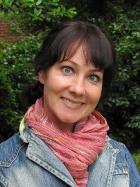 Kerrie Anne Loyd (Univ. of Georgia)
Kerrie Anne Loyd (Univ. of Georgia)
Project Title: A stochastic modeling approach to feral cat management and prey take
Kerrie Anne Loyd's project examines the effect of alternative feral cat management options on cat populations, prey take and predation on a focal species over a 10-year period.
Click here to view the NIMBioS video interview: What to do about feral cats?.
Visit Dates: May 10-14, 2010
NIMBioS video: What to do about feral cats?
 Jeremy Van Cleve (Santa Fe Institute)
Jeremy Van Cleve (Santa Fe Institute)
Project Title: Exploring two-tier models of social behavior in structured populations
Jeremy Van Cleve is collaborating with Erol Akçay (NIMBioS) to explore two-tier models of social behavior in structured populations.
Visit Dates: March 24-31, 2010
Products
Publication: Akcay E, Van Cleve J. 2012. Behavioral responses in structured populations pave the way to group optimality. The American Naturalist, 179(2): 257-269. [Online]
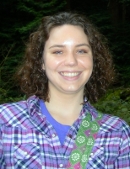 Judith Canner (North Carolina State Univ.)
Judith Canner (North Carolina State Univ.)
Project Title: The effects of climate change on ant population dynamics and ant-plant mutualisms
To understand the factors controlling the seasonal abundance of ants, Judith Canner is collaborating with Sharon Bewick (NIMBioS) and Katie Stuble (Univ. of Tennessee) to develop a stage-structured model of colony dynamics.
The goal is to understand how temperature, which alters the developmental and mortality rates of eggs, larvae and pupae, can influence the seasonal abundance of workers in the colony and, ultimately, colony survival.
Visit Dates: March 14-19, 2010
Report
Products
Dissertation: Canner J. 2010. The population ecology of ant-dispersed plants in space and time. North Carolina State University, Raleigh, NC.
Presentation: Canner J. May 2011. How do we measure the response of species interactions to climate change? The use of models and experiments to study myrmecochory. SIAM Conference on Applications of Dynamical Systems.
Presentation: Canner J. January 2011. How do we measure the response of species interactions to climate change? The use of models and experiments to study myrmecochory. MAA-AMS Joint Mathematics Meeting, New Orleans, LA.
Proposal: Canner J. 2011. The effects of climate change on the interactions between ants and plants. Monterey Bay Faculty Research, Scholarship, and Creative Activity (FRSCA), California State Univ. $5,833. Accepted.
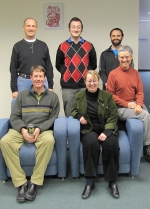 Hoeksema et al.
Hoeksema et al.
Project Title: Production economics of mutualism: Rhizobial bail-outs to the domatia bubble
The collaborative team of Jason Hoeksema (Univ. of North Carolina, Chapel Hill); Erol Akçay (NIMBioS); James Umbanhower (Univ. of North Carolina, Chapel Hill); Sarah Richardson (DePaul Univ.); Ellen Simms (UC Berkeley); Antonio Golubski (Univ. of Toronto); and Miro Kummel (Colorado College) is developing a general framework for using economic theory to model how mutualisms evolve and how they create and respond to ecological change.
Visit Dates: Feb. 19-21, 2010
Products
Book Chapter: Hoeksema JD, Bruna EM. 2015. Context-dependent outcomes in mutualisms. In: Brontein J (ed.), Mutualism, Oxford University Press.
Grant/Proposal: Hoeksema JD, Booth MG. 2011-2014. Collaborative Research: Price determination in ectomycorrhizal symbioses. National Science Foundation. $420,000. Accepted.
 Ellen Simms (Univ. of California, Berkeley)
Ellen Simms (Univ. of California, Berkeley)
Project Title: Modeling nodulation dynamics of legumes
Ellen Simms is collaborating with Erol Akçay (NIMBioS) to develop a model of the nodulation process and its regulation, based on available empirical evidence, and embed the partner choice and negotiation models into this dynamic framework.
Visit Dates: Jan. 27-31, 2010
Visitors work on-site at NIMBioS and may link the visit with a Working Group or other activity at NIMBioS. Visitors receive reimbursement for travel and housing expenses as well as a per diem.
Applications can include any type of interdisciplinary synthesis project, but NIMBioS particularly welcomes collaborative projects. Such collaborations might involve NIMBioS resident researchers or staff or local researchers; joint applications from two or more researchers to spend time together at NIMBioS; or applications from participants in other NIMBioS activities to work on their project with NIMBioS computational science staff.
Applications are considered four times a year, with deadlines on March 1, June 1, September 1, and December 1. Applications are evaluated in terms of both the scientific value of the project and the qualifications of the applicant. Particular priority is given to students and junior researchers.
For more information about short-term visits and how to apply, click here.
NIMBioS
1122 Volunteer Blvd., Suite 106
University of Tennessee
Knoxville,
TN 37996-3410
PH: (865) 974-9334
FAX: (865) 974-9461
Contact NIMBioS


